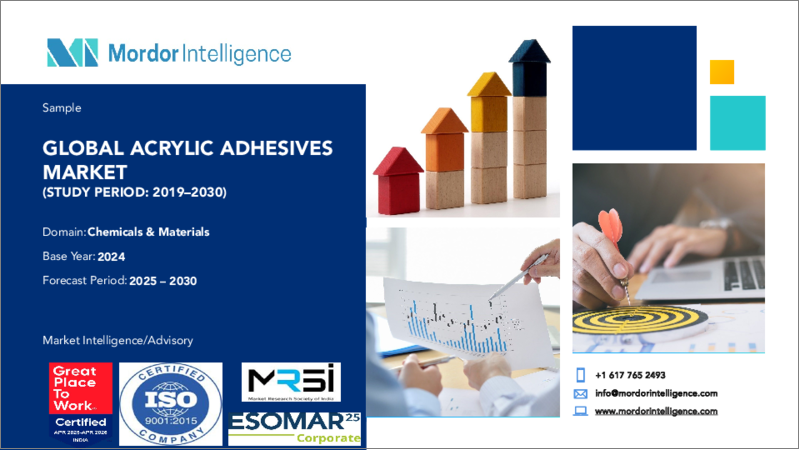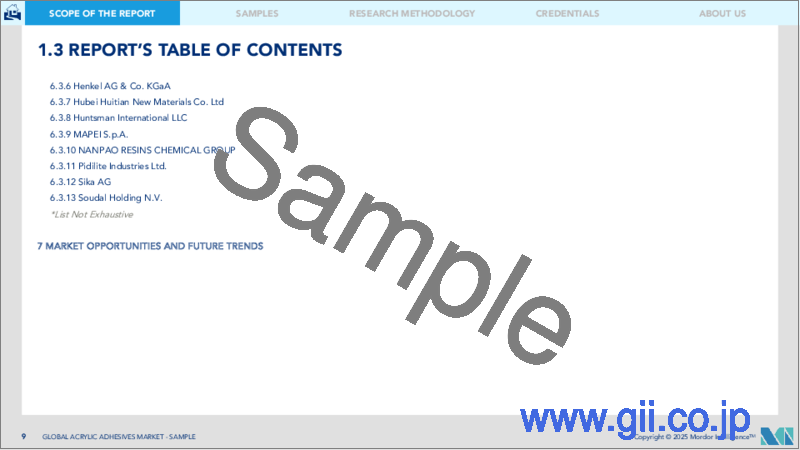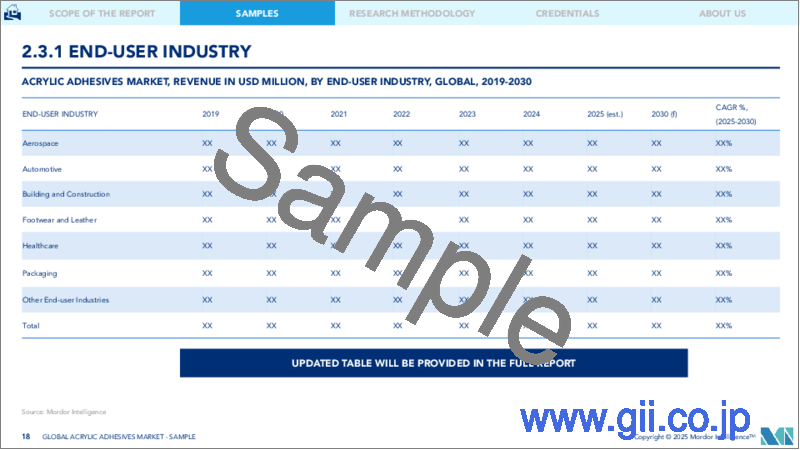|
|
市場調査レポート
商品コード
1693421
アクリル系粘着剤:市場シェア分析、産業動向と統計、成長予測(2025~2030年)Acrylic Adhesives - Market Share Analysis, Industry Trends & Statistics, Growth Forecasts (2025 - 2030) |
||||||
カスタマイズ可能
適宜更新あり
|
|||||||
| アクリル系粘着剤:市場シェア分析、産業動向と統計、成長予測(2025~2030年) |
|
出版日: 2025年03月18日
発行: Mordor Intelligence
ページ情報: 英文 326 Pages
納期: 2~3営業日
|
全表示
- 概要
- 目次
概要
アクリル系粘着剤の市場規模は2024年に158億9,000万米ドルと推定され、2028年には201億4,000万米ドルに達すると予測され、予測期間中(2024~2028年)にCAGR 6.10%で成長する見込みです。

材料技術の進歩がアクリル系粘着剤の成長を促進
- アクリル系粘着剤は、防水、耐候性シール、ひび割れシール、接着などの用途があるため、建設産業で広く使用されています。世界の建設産業は、2030年まで毎年3.5%の成長が見込まれています。2021年の世界建設市場の成長率は、アジア太平洋と欧州が67%を占めています。このように、建設用アクリル系粘着剤は、世界の粘着剤市場において数量ベースで最大のシェアを占めています。
- 粘着剤は、ガラス、金属、プラスチック、塗装面などの表面に適用されるため、自動車産業で広く使用されています。その特徴は、極端な耐候性、耐久性、長持ちなど、自動車産業で役立っています。これらはエンジンや自動車のガスケットに使用されています。自動車産業の電気自動車セグメントは、成長経済圏での需要増加により、予測期間2022~2028年に世界全体で17.75%のCAGRで推移すると予想されています。このため、予測期間2022~2028年には自動車用アクリル系接着剤の需要が増加すると予想されます。
- さまざまな接着剤は、電子機器や電気機器の製造に広く使用されています。これらはセンサやケーブルの接着やシールに使用されます。電子機器産業と民生用電子機器産業はそれぞれ2.51%と5.77%のCAGRで推移すると予想され、予測期間2022~2028年にアクリル系粘着剤の需要増加につながります。
- 医療産業では、医療機器部品の組み立てなどの用途に粘着剤が使用されています。世界の医療投資の増加は、予測期間2022~2028年のアクリル系粘着剤需要の増加につながると予想されます。
アジア太平洋と欧州がアクリル系粘着剤の世界需要を担う
- アジア太平洋は、建設包装活動、自動車、医療機器、航空宇宙産業の生産能力が高く、その他のエンドユーザー産業も確立されているため、調査期間全体を通じてアクリル系粘着剤の需要で最大のシェアを占めています。中国は世界最大の建設と自動車市場であり、2021年にはアジア太平洋の需要の最大55%を占めます。
- 2017年から19年にかけて、アクリル系粘着剤の需要は安定した成長を見せた。欧州と北米の建設包装産業からの需要増が成長の主要原動力となりました。自動車産業からの需要が世界的に減少したことが、この期間のアクリル系粘着剤需要の成長を制限しました。
- 2020年には、COVID-19パンデミックのため、すべてのエンドユーザー産業からのアクリル系粘着剤需要が減少しました。南アフリカやブラジルなどその他の国では、パンデミックの間、建設活動が不可欠とみなされ、操業が許可されました。こうした要因が世界の影響を緩和し、減少幅は6.69%に抑制されました。
- 2021年には、米国、オーストラリア、EU諸国などの救済策や支援制度により、需要が回復し始め、この成長動向は予測期間を通じて続くと予想されます。欧州、南米、アジア太平洋で見られる投資と予算配分の増加は、この成長の主要促進要因になると予想されます。アクリル系粘着剤の世界需要は、予測期間2022~2028年にCAGR 4.43%で成長すると予測されます。
世界のアクリル系粘着剤市場動向
発展途上国でのeコマース産業の急成長により、産業が増強される
- 2020年、包装産業は複数の長期的動向が需要増を牽引してスタートし、経済活動がCOVID-19パンデミックによる課題への対応に切り替わるにつれて成長が加速しました。産業の堅調な業績は、収益の増加と、飲食品や医療などの重要な最終市場の拡大を支え、また、経済全体が不透明な時期にも産業の全般的な安定性を実証しました。
- 2020年のパンデミック(世界的大流行)でほとんどディールメーキングが停止した後、売り手と買い手が熱心に市場に戻ってきたため、2021年の包装M&A活動は急増しました。パンデミックの間、包装企業の好調な業績は、包装産業が全般的な市場の混乱時に安定性を提供するという考えを強化しました。パンデミックはまた、eコマースの急速な拡大や、スーパーマーケットの棚で製品を差別化するために包装を採用するブランドオーナーなど、以前からあった追い風を強化し、このセクタをより強力な長期成長へと位置づけた。
- 現在のところ、溶解可能な包装、省スペース包装、スマート包装は、包装産業で生まれたいくつかのイノベーションです。食用包装の採用は、化石燃料への依存を軽減し、カーボンフットプリントを大幅に減少させる可能性を秘めた興味深く革新的な代替手段であり、その持続可能性により食品産業全体に普及しつつあります。こうした要因が飲食品セグメントの包装産業に成長機会をもたらしており、予測期間中の包装産業の成長を後押しすると期待されています。
成長する住宅とインフラ開発による建設セクタの繁栄
- 建築・建設産業は着実な成長を示し、2017~2019年のCAGRは2.6%でした。この成長は、世界の経済活動の上向きと一戸建て住宅の需要増加が牽引しました。2020年、COVID-19パンデミックは世界の建築・建設産業に大きな影響を与えました。労働力供給の制約、建設財政とサプライチェーンの混乱、経済の不確実性が世界の建築・建設産業にマイナスの影響を与えました。
- 2021年にはプラス成長を示したもの、パンデミックによるサプライチェーンへの影響は原料価格の高騰を招き、いまだ産業を悩ませています。しかし、建設産業は国の経済に大きな影響を与えるため、北米、アジア太平洋の国々は、支援制度を提供することで、経済サイクルを再起動させるために建設産業を利用してきました。支援制度には、オーストラリアのホームビルダープログラムやEU諸国の景気回復計画などがあります。
- アジア太平洋は建設活動量が最も多く、中国、インド、日本、インドネシア、韓国などの国々における膨大な人口、都市化の進展、インフラ開拓への投資の増加により、2028年まで最大の建設市場であり続けると予想されます。
- グリーンビルディングの重視が高まり、世界の建設活動からの排出を削減する取り組みが進むことで、予測期間中、よりサステイナブル運営手順が実現すると予想されます。例えばフランスは、低炭素エネルギー経済への転換を図るため、建設産業に75億ユーロの予算を計上しています。
アクリル接着剤産業概要
アクリル接着剤市場は細分化されており、上位5社で19.23%を占めています。この市場の主要企業は、3M、AVERY DENNISON CORPORATION、H.B. Fuller Company、Henkel AG & Co. KGaA、Sika AGなどです。
その他の特典
- エクセル形式の市場予測(ME)シート
- 3ヶ月のアナリストサポート
目次
第1章 エグゼクティブサマリーと主要調査結果
第2章 レポートのオファー
第3章 イントロダクション
- 調査の前提条件と市場定義
- 調査範囲
- 調査手法
第4章 主要産業動向
- エンドユーザー動向
- 航空宇宙
- 自動車
- 建築・建設
- フットウェア皮革
- 包装
- 規制の枠組み
- アルゼンチン
- オーストラリア
- ブラジル
- カナダ
- 中国
- EU
- インド
- インドネシア
- 日本
- マレーシア
- メキシコ
- ロシア
- サウジアラビア
- シンガポール
- 南アフリカ
- 韓国
- タイ
- 米国
- バリューチェーンと流通チャネル分析
第5章 市場セグメンテーション
- エンドユーザー産業
- 航空宇宙
- 自動車
- 建築・建設
- フットウェアと皮革
- 医療
- 包装
- その他
- 技術
- 反応性
- 溶剤系
- UV硬化型接着剤
- 水性
- 地域
- アジア太平洋
- オーストラリア
- 中国
- インド
- インドネシア
- 日本
- マレーシア
- シンガポール
- 韓国
- タイ
- その他のアジア太平洋
- 欧州
- フランス
- ドイツ
- イタリア
- ロシア
- スペイン
- 英国
- その他の欧州
- 中東・アフリカ
- サウジアラビア
- 南アフリカ
- その他の中東・アフリカ
- 北米
- カナダ
- メキシコ
- 米国
- その他の北米地域
- 南米
- アルゼンチン
- ブラジル
- その他の南米
- アジア太平洋
第6章 競合情勢
- 主要な戦略動向
- 市場シェア分析
- 企業情勢
- 企業プロファイル
- 3M
- Arkema Group
- AVERY DENNISON CORPORATION
- Dow
- H.B. Fuller Company
- Henkel AG & Co. KGaA
- Hubei Huitian New Materials Co. Ltd
- Huntsman International LLC
- Jowat SE
- Kangda New Materials(Group)Co., Ltd.
- MAPEI S.p.A.
- NANPAO RESINS CHEMICAL GROUP
- Pidilite Industries Ltd.
- Sika AG
- Soudal Holding N.V.
第7章 CEOへの主要戦略的質問
第8章 付録
- 世界の接着剤・シーラント産業概要
- 概要
- ファイブフォース分析フレームワーク(産業魅力度分析)
- 世界のバリューチェーン分析
- 促進要因、抑制要因、機会
- 情報源と参考文献
- 図表一覧
- 主要な洞察
- データパック
- 用語集
目次
Product Code: 92480
The Acrylic Adhesives Market size is estimated at 15.89 billion USD in 2024, and is expected to reach 20.14 billion USD by 2028, growing at a CAGR of 6.10% during the forecast period (2024-2028).

Advancement in material technology to augment the growth of acrylic adhesives
- Acrylic adhesives are widely used in the construction industry because of their applications, such as waterproofing, weather-sealing, cracks sealing, and bonding. The construction industry globally is expected to grow 3.5% annually up to 2030. Asia-Pacific and Europe accounted for 67% of the global construction market's growth in 2021. Thus, construction acrylic adhesives account for the largest share of the global adhesives market by volume.
- Adhesives are widely used in the automotive industry because of their application to surfaces such as glass, metal, plastic, and painted surfaces. Their features are helpful in the automotive industry, such as extreme weather resistance, durability, and long-lasting. These are used in engines and car gaskets. The electric vehicles segment of the automotive industry is expected to record a 17.75% CAGR globally in the forecast period, 2022-2028, because of the increased demand in growing economies. This is expected to increase demand for automotive acrylic adhesives in the forecast period 2022-2028.
- Different adhesives are widely used in electronics and electrical equipment manufacturing. They are used for bonding and sealing sensors and cables. The electronics and household appliances industries are expected to record CAGRs of 2.51% and 5.77%, respectively, which will lead to an increase in demand for acrylic adhesives in the forecast period 2022-2028.
- Adhesives are used in the healthcare industry for applications such as assembling medical device parts. The increase in healthcare investments worldwide is expected to lead to an increase in demand for acrylic adhesives in the forecast period 2022-2028.
Asia-Pacific and Europe to carry the global demand for acrylic adhesives
- The Asia-Pacific region accounted for the largest share of the demand for acrylic adhesives throughout the entire study period because of the large number of construction and packaging activities, automotive, medical devices, and aerospace production capacities, and other well-established end-user industries in the region. China is the largest construction and automotive market globally and accounted for up to 55% of the demand from the Asia-Pacific region in 2021.
- During 2017-19, the demand for acrylic adhesives witnessed steady growth. The rising demand from construction and packaging industries in Europe and North America were major drivers of growth. The decline of the demand from the automotive industry globally restricted the growth of the demand for acrylic adhesives during this period. declined with a CAGR of 2.89% during this period, 2017-19.
- In 2020, the demand for acrylic adhesives from all end-user industries declined because of the covid-19 pandemic. In some countries like South Africa, and Brazil among others construction activities were deemed essential and were allowed to operate during the pandemic. Factors like these have cushioned the global impact restricting the decline to 6.69%.
- In 2021, due to the relief packages and support schemes in countries like the United States, Australia, and countries in the EU among others, the demand started to recover and this growth trend is expected to continue throughout the forecast period. Increased investments and budget allotments witnessed in countries of Europe, South America, and the Asia Pacific regions are expected to be major driving factors for this growth. The global demand for acrylic adhesives is expected to grow with a CAGR of 4.43% during the forecast period, 2022-2028.
Global Acrylic Adhesives Market Trends
Fast paced growth of e-commerce industry in developing nations to augment the industry
- In 2020, the packaging industry started with multiple long-term trends driving higher demand, and growth accelerated as economic activity switched to address the challenges posed by the COVID-19 pandemic. The industry's robust performance supported rising revenues and the expansion of important end markets such as food and beverage and healthcare and also demonstrated the industry's general stability during a period of overall economic uncertainty.
- Packaging M&A activities soared in 2021, as buyers and sellers enthusiastically returned to the market after deal-making almost ceased during the pandemic in 2020. During the pandemic, the strong performance of packaging companies reinforced the idea that the industry offers stability during moments of general market turbulence. The pandemic also strengthened previously existing tailwinds, including rapid e-commerce expansion and brand owners employing packaging to differentiate their products on supermarket shelves, positioning the sector for stronger long-term growth.
- As of now, dissolvable packaging, space-saving packaging, and smart packaging are a few innovations that have come up in the packaging industry. The adoption of edible packaging, an interesting and innovative alternative that alleviates the reliance on fossil fuels and has the potential to significantly decrease the carbon footprint, is now becoming popular across the food industry owing to its sustainability. These factors have created a growth opportunity for the packaging industry in the food and beverage sector, which is expected to boost the packaging industry's growth during the forecast period.
Growing residential and infrastructural development to thrive the construction sector
- The building and construction industry witnessed steady growth, with a CAGR of 2.6% from 2017 to 2019. This growth was driven by the upswing in global economic activity and increasing demand for single-family homes. In 2020, the COVID-19 pandemic had a major impact on the global building and construction industry. Constraints in labor supply, disruptions in construction finances and the supply chain, and economic uncertainty negatively impacted the global building and construction industry.
- Though the industry showed positive growth in 2021, the pandemic's effect on supply chains, which resulted in a hike in raw material prices, is still plaguing the industry. However, as the construction industry heavily influences a nation's economy, countries in Europe, North America, and Asia-Pacific have used the construction industry to restart their economic cycles by offering support schemes. Some support schemes include the Homebuilder Programme in Australia and the economic recovery plan of EU countries.
- The Asia-Pacific region experiences the highest volume of construction activities, and it is expected to remain the largest construction market till 2028 due to its huge population, increasing urbanization, and increasing investments in infrastructural development in countries like China, India, Japan, Indonesia, and South Korea.
- Increasing emphasis on green buildings and efforts to reduce emissions from global construction activities are expected to result in more sustainable operational procedures during the forecast period. For example, France has sanctioned EUR 7.5 billion for the construction industry to transform itself into a low-carbon energy economy.
Acrylic Adhesives Industry Overview
The Acrylic Adhesives Market is fragmented, with the top five companies occupying 19.23%. The major players in this market are 3M, AVERY DENNISON CORPORATION, H.B. Fuller Company, Henkel AG & Co. KGaA and Sika AG (sorted alphabetically).
Additional Benefits:
- The market estimate (ME) sheet in Excel format
- 3 months of analyst support
TABLE OF CONTENTS
1 EXECUTIVE SUMMARY & KEY FINDINGS
2 REPORT OFFERS
3 INTRODUCTION
- 3.1 Study Assumptions & Market Definition
- 3.2 Scope of the Study
- 3.3 Research Methodology
4 KEY INDUSTRY TRENDS
- 4.1 End User Trends
- 4.1.1 Aerospace
- 4.1.2 Automotive
- 4.1.3 Building and Construction
- 4.1.4 Footwear and Leather
- 4.1.5 Packaging
- 4.2 Regulatory Framework
- 4.2.1 Argentina
- 4.2.2 Australia
- 4.2.3 Brazil
- 4.2.4 Canada
- 4.2.5 China
- 4.2.6 EU
- 4.2.7 India
- 4.2.8 Indonesia
- 4.2.9 Japan
- 4.2.10 Malaysia
- 4.2.11 Mexico
- 4.2.12 Russia
- 4.2.13 Saudi Arabia
- 4.2.14 Singapore
- 4.2.15 South Africa
- 4.2.16 South Korea
- 4.2.17 Thailand
- 4.2.18 United States
- 4.3 Value Chain & Distribution Channel Analysis
5 MARKET SEGMENTATION (includes market size in Value in USD and Volume, Forecasts up to 2028 and analysis of growth prospects)
- 5.1 End User Industry
- 5.1.1 Aerospace
- 5.1.2 Automotive
- 5.1.3 Building and Construction
- 5.1.4 Footwear and Leather
- 5.1.5 Healthcare
- 5.1.6 Packaging
- 5.1.7 Other End-user Industries
- 5.2 Technology
- 5.2.1 Reactive
- 5.2.2 Solvent-borne
- 5.2.3 UV Cured Adhesives
- 5.2.4 Water-borne
- 5.3 Region
- 5.3.1 Asia-Pacific
- 5.3.1.1 Australia
- 5.3.1.2 China
- 5.3.1.3 India
- 5.3.1.4 Indonesia
- 5.3.1.5 Japan
- 5.3.1.6 Malaysia
- 5.3.1.7 Singapore
- 5.3.1.8 South Korea
- 5.3.1.9 Thailand
- 5.3.1.10 Rest of Asia-Pacific
- 5.3.2 Europe
- 5.3.2.1 France
- 5.3.2.2 Germany
- 5.3.2.3 Italy
- 5.3.2.4 Russia
- 5.3.2.5 Spain
- 5.3.2.6 United Kingdom
- 5.3.2.7 Rest of Europe
- 5.3.3 Middle East & Africa
- 5.3.3.1 Saudi Arabia
- 5.3.3.2 South Africa
- 5.3.3.3 Rest of Middle East & Africa
- 5.3.4 North America
- 5.3.4.1 Canada
- 5.3.4.2 Mexico
- 5.3.4.3 United States
- 5.3.4.4 Rest of North America
- 5.3.5 South America
- 5.3.5.1 Argentina
- 5.3.5.2 Brazil
- 5.3.5.3 Rest of South America
- 5.3.1 Asia-Pacific
6 COMPETITIVE LANDSCAPE
- 6.1 Key Strategic Moves
- 6.2 Market Share Analysis
- 6.3 Company Landscape
- 6.4 Company Profiles (includes Global Level Overview, Market Level Overview, Core Business Segments, Financials, Headcount, Key Information, Market Rank, Market Share, Products and Services, and Analysis of Recent Developments).
- 6.4.1 3M
- 6.4.2 Arkema Group
- 6.4.3 AVERY DENNISON CORPORATION
- 6.4.4 Dow
- 6.4.5 H.B. Fuller Company
- 6.4.6 Henkel AG & Co. KGaA
- 6.4.7 Hubei Huitian New Materials Co. Ltd
- 6.4.8 Huntsman International LLC
- 6.4.9 Jowat SE
- 6.4.10 Kangda New Materials (Group) Co., Ltd.
- 6.4.11 MAPEI S.p.A.
- 6.4.12 NANPAO RESINS CHEMICAL GROUP
- 6.4.13 Pidilite Industries Ltd.
- 6.4.14 Sika AG
- 6.4.15 Soudal Holding N.V.
7 KEY STRATEGIC QUESTIONS FOR ADHESIVES AND SEALANTS CEOS
8 APPENDIX
- 8.1 Global Adhesives and Sealants Industry Overview
- 8.1.1 Overview
- 8.1.2 Porter's Five Forces Framework (Industry Attractiveness Analysis)
- 8.1.3 Global Value Chain Analysis
- 8.1.4 Drivers, Restraints, and Opportunities
- 8.2 Sources & References
- 8.3 List of Tables & Figures
- 8.4 Primary Insights
- 8.5 Data Pack
- 8.6 Glossary of Terms





